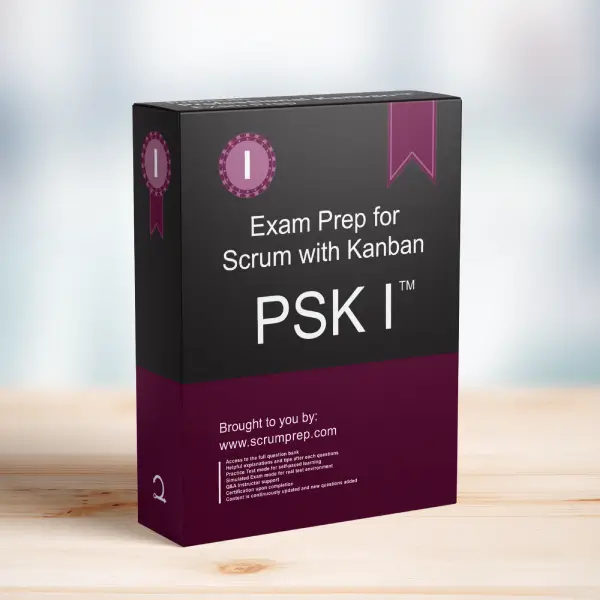Kanban and the Scrum Theory of Empiricism
Understanding the relationship between Kanban and the Scrum theory of empiricism is crucial for optimizing workflow and improving team performance in a Scrum environment.
Exam Question
Which of these statements are true about Kanban and the Scrum theory of empiricism?
(choose the best two answers)
A. The Kanban board provides Scrum Teams with transparency that helps them inspect and adapt their process.
B. Kanban metrics are used in the Sprint Review to allow the Product Owner to inspect the Throughput and adapt the Scrum Team’s Cycle Time.
C. Kanban helps Scrum Teams deal with simple and complicated work where empiricism is not necessary.
D. Kanban helps Scrum Teams achieve faster, healthier flow. That brings more rapid transparency about the product, enabling a more effective inspection and adaptation loop.
Correct Answers
A. The Kanban board provides Scrum Teams with transparency that helps them inspect and adapt their process.
D. Kanban helps Scrum Teams achieve faster, healthier flow. That brings more rapid transparency about the product, enabling a more effective inspection and adaptation loop.
Explanation
Correct Answers
A. The Kanban board provides Scrum Teams with transparency that helps them inspect and adapt their process:
The Kanban board is a visual tool that enhances transparency by making the workflow visible to the entire team. This transparency is essential for the Scrum pillars of inspection and adaptation, as it allows the team to see the current state of work, identify bottlenecks, and make informed decisions to improve their process.
D. Kanban helps Scrum Teams achieve faster, healthier flow. That brings more rapid transparency about the product, enabling a more effective inspection and adaptation loop:
By promoting a smoother and more predictable flow of work, Kanban helps Scrum Teams gain faster feedback and insights about their product. This rapid transparency enables more frequent and effective inspection and adaptation, which are key components of the Scrum framework.
Why the Other Options Are Less Effective
B. Kanban metrics are used in the Sprint Review to allow the Product Owner to inspect the Throughput and adapt the Scrum Team’s Cycle Time:
While Kanban metrics can be discussed during Sprint Review, the primary purpose of the Sprint Review is to inspect the Increment and adapt the Product Backlog. The Product Owner focuses on maximizing product value rather than directly adapting the team’s Cycle Time based on Kanban metrics.
C. Kanban helps Scrum Teams deal with simple and complicated work where empiricism is not necessary:
Empiricism is a fundamental aspect of Scrum, applicable to all types of work, whether simple or complex. Kanban complements Scrum by enhancing the empirical process of inspection and adaptation, rather than replacing it in certain scenarios.
Importance of Kanban in Scrum
- Enhanced Transparency: Kanban boards and metrics provide greater visibility into the workflow, helping teams understand and improve their processes.
- Improved Flow: By managing WIP and optimizing flow, Kanban helps teams deliver work more efficiently and consistently.
- Faster Feedback: Rapid feedback loops enabled by Kanban support more frequent inspection and adaptation, leading to continuous improvement.
Effective Practices for Integrating Kanban with Scrum
- Visualize Workflow: Use Kanban boards to make the workflow transparent and visible to all team members.
- Manage WIP: Set and enforce WIP limits to maintain a steady flow of work and prevent bottlenecks.
- Monitor Metrics: Regularly track and analyze Kanban metrics such as Cycle Time, Throughput, and WIP to gain insights and drive improvements.
Relevance to the PSK I Exam
Understanding how Kanban supports the Scrum theory of empiricism is crucial for the PSK I exam. It demonstrates knowledge of integrating Kanban practices with Scrum to enhance transparency, inspection, and adaptation.
Key Takeaways
- Kanban boards provide transparency, helping teams inspect and adapt their processes.
- Kanban improves workflow, enabling faster feedback and more effective inspection and adaptation.
- Empiricism is fundamental to Scrum, and Kanban enhances this by providing tools and practices for better visibility and continuous improvement.
Conclusion
Kanban complements the Scrum theory of empiricism by providing tools and practices that enhance transparency, improve workflow, and support continuous improvement. For more information on preparing for the PSK I exam, visit our Professional Kanban PSK I™ Exam Prep.



